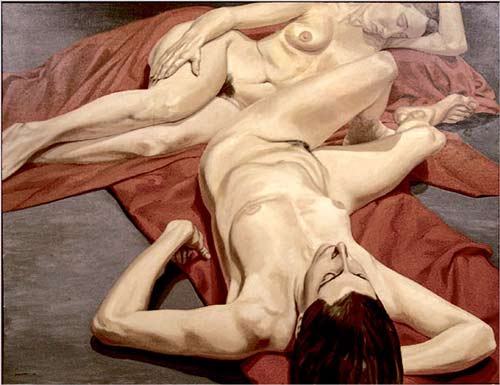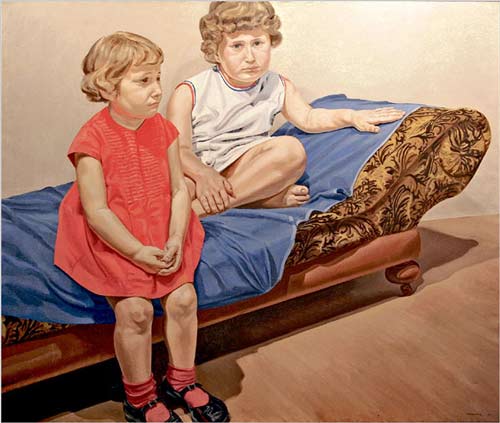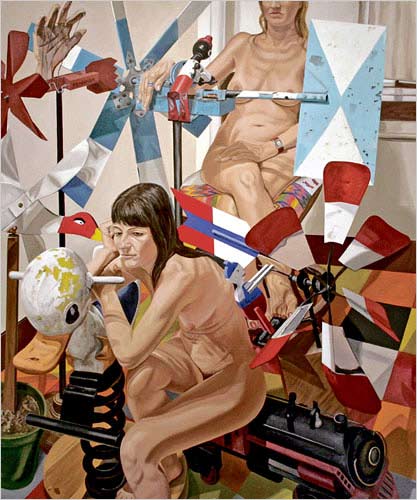return to homepage Philip Pearlstein
return to updates
and the plastic nude
This month [January, 2009] Philip Pearlstein’s small retrospective in Montclair, NJ, is reviewed by Ken Johnson of the New York Times. Johnson begins the review like this:
Around 1961, when he was in his late 30s, Mr. Pearlstein began to paint pictures of nude people from life. It was an old-fashioned idea, but in his hands, it became shockingly modern. He stripped the nude of almost all its customary associations. Beauty, eroticism, mythology, allegory: all the traditional justifications for nudity in painting were gone, leaving only the bare fact of the naked human body.
As usual, I seek sense in that paragraph, and also as usual I fail to find it. Johnson’s article is not a critique, so none of this is meant as condemnation of Pearlstein. It is meant to be self-explanatory: anyone reading this will know who Pearlstein is, why else would they read it? If they are reading it, they probably like Pearlstein, so there is no reason to say anything substantive. All the readers need is a bit of tweeking from their daily slumbers, a bit of reminding they are still alive and can still read (or what now passes for it) in one modern language. So this introduction is a set of four sub-declarative sentences, posing as a meaningful pastime.
Painting nudes is neither old-fashioned nor modern, although Johnson implies in a quiet, almost sneaking way, that it is. If we are to follow his noodly nudge, we must accept without thinking that the old-fashioned way to paint nudes was via beauty, eroticism, myth, and/or allegory. The modern way is to ignore them all. If a painter ignores them all, we are left with only a “bare fact.”
If I were to try to insert some meaning into this sentence, I would say that a good artist gives us an image that is rich in some way. It may contain one or more of Johnson’s categories here or not, but it certainly will contain something. This applies to any good artist, of the past or present. An artist of the past who offers us an empty painting is a bad artist, and likewise for an artist of the present. Why would a viewer or reviewer be interested in a empty painting? Why should we care about the emptiness, as emptiness?
Notice that Johnson does not tell us what Pearlstein’s paintings do contain, instead of beauty and so on. We are supposed to understand that Pearlstein’s paintings are modern—and therefore automatically interesting to modern viewers—not for what they contain, but for what they lack. Modern art is a bare fact.
But is it? What, really, is a bare fact? What is a realistic subject stripped of all convention and category and intention? Is it a better painting? Is it a more interesting painting? With Pearlstein, we have a clear answer, though Johnson will not tell it to us. The answer is no, it is not a better painting. It is an empty painting, which is a worse painting.
This would be the natural way to steer any review of Pearlstein, but Johnson must paddle the other direction. He must seem to be writing a review while almost silently continuing a long and subtle lie. We must get to the end of these faux-sentences without once realizing we are traveling head-downwards. More than that, we must get to the end of them firm in our old (but still avant) belief that nothing is something.
We must believe the paradox: that stripping all meaning from something makes it more meaningful. “It is crushingly, grindingly empty, but it is modern, therefore its emptiness fills us!”
Johnson continues,
Realism returned from the dead in the 1960s, and Philip Pearlstein was one of its chief revivers.
That sentence appears to give Pearlstein a positive action, but let us unwind it. To revive something, you must fill it with some kind of life, but Johnson just admitted that Pearlstein’s talent and credit was stripping away, down to the bare fact. So he did not revive the corpse, he re-embalmed it.
And why was realism dead in the early 60’s? Johnson doesn’t want us to ask that question, he just wants the past to be dead and the present to be alive. But was it because normal people were sick of old-fashioned nudes, nudes with beauty and eroticism and so on? No. It was because theory and politics had killed all possibility of art for decades. Artists and professional viewers alike had become so anemic, so used to the bloodless wasteland, that they could not stand any signs of life or health. Realism did not return in the 60’s and it still has not returned. Only subject matter returned. Artists were allowed to paint things, but only stripped down bare-fact things. Things used as signposts for other things, things empty and torn and flapping in the cold modern breeze. But never things for their own sake.
Never even bare facts, since facts have content. No, the modern painter is a painter of factoids. The shells and husks of facts, the outlines of ghosts of things that were once facts.
This is Pearlstein’s place in the 20th century: he was the precursor of John Currin, the soulless modern posing as the revivalist. The only way to make the nude any deader than it was in the 50’s was to bring it back, to lay it on the dissecting table and to force people to look at its awful decay. To shove the rotting flesh in the face of the gasping public, as with Lucian Freud, or to prove to the still hopeful and naïve that the body had already gone to bone, as with Currin, or to ruin the last tiny erection by showing the plastic future already here and permanent, as with the brittle mannequins of Pearlstein.
And yet the body in Mr. Pearlstein’s pictures — usually young, healthy and female — could not be completely neutralized. Tension between clinical objectivity and psychosexual intrigue gives the pictures a weird undercurrent, as if the painter were wrestling with his desires and almost but not quite overcoming them.
Healthy? Can mannequins be either healthy or unhealthy? Because we see plastic skin instead of Freud’s rotting skin, this is health? I don’t find any psychosexual intrigue in Pearlstein’s nudes, but supposing Pearlstein or Johnson do, the question is begged why either man should be wrestling with these desires. If you desire a mannequin, buy one and have your way. Where is the psychology or the intrigue?
And why “clinical objectivity”? How is there any tension between clinical objectivity and desire? Who is requiring the artist to have clinical objectivity if all he wants is a toss, or who is requiring him to have desires if he doesn’t? There is no tension in Pearlstein’s paintings, but there is also no tension between objectivity and desire. The sentence and the psychology is just as manufactured and fake as the art.
To say it outright, the tension in a nude normally comes from another place. If there is a tension or a guilt or a negative frisson in a nude, it normally comes from the still semi-taboo state of nudity. Either that or it comes from the fact that the male artist is married, and he is not supposed to be too interested in these naked females. He is walking a fine line, and that causes the tension. But that is not what Johnson is talking about here. It is not Pearlstein's wife that is demanding a clinical objectivity, it is criticism and theory that are demanding it. "We will allow the nude back in, but only if you agree to paint it as a modern. To do this, you MUST ditch beauty, eroticism, myth, allegory, and every other positive intention or convention." It is in this way that the tension is manufactured, since it has nothing to do with any feeling or repressed feeling of the artist. It has to do with a theoretical requirement, a requirement of theory and politics. Such a requirement has nothing at all to do with psychology or art, it is only a function of the market. Any painter who would agree to these terms is not an artist.
Beyond that, has anyone ever imagined the possibility that Pearlstein was trying to be interesting in some way, but just failed? Has anyone imagined that Pearlstein was trying to be beautiful or erotic and just failed? Has anyone ever thought that maybe, just maybe, Pearlstein is a lousy painter, and nothing more? If you check all the reviews of the past fifty years, no one ever did before me.
Perhaps Pearlstein wasn't trying to deliver the goods to Modernism. Perhaps he wasn't a market whore. Perhaps he was just another mediocre artist, one who happened to be tapped by Modernism to fill the shoes of the moment. Modernism wanted empty realism, and Pearlstein happened to be able to create it. Just as he didn't have the talent to fill a painting with emotion, he didn't have the backbone to stand up and say, "No, I don't want your phony praise. I don't want your dirty money. I don't want to have anything to do with Modernism and all its lies. I don't want to be remembered in the same sentence as Andy Warhol and the rest of those awful people. Just leave me alone!"
Johnson, false to the flag, ends with this,
But if it’s a question of contributing something original and influential to 20th-century art, only Mr. Pearlstein’s nudes will answer.
Pearlstein’s nudes were not original, in that marginally talented artists had been failing to create interesting nudes for centuries. And Pearlstein's particular failure was not original either: the bad photocopy is as old as the photograph. I don't believe for a minute that these paintings were done from life. It is physically impossible to make a painting from life look so much like a painting from a bad photo. The evidence is all there, and any realist painter should know how to read it.
Once again Johnson simply assumes that Pearlstein’s influence is a good thing, when the reverse is true. Johnson says it with a smile, when a frown is the only thing that will do. Yes, Pearlstein was influential, in that his success made possible the success of a long line of pseudo-realists, down to Fishl and Currin. Johnson can’t state it like that, but the future will.
These painters are not realists. They did not re-vivify realism or the figure or the nude. What they did is use the nude to kill the nude, use realism to kill realism. They are anti-realists. They are Futurists painting figures to further damage the history of figuration. Pearlstein, Freud, Saville, Fishl, Currin, Stuart Pearson Wright, Hockney, Koons, Richter, Hirst, Katz, Close: all were drafted by Modernism to guarantee that the figure and the nude would not become viable again in the major markets. Modernism made them famous instead of real artists. The great danger to Modernism has always been the return of the real artist, painting real things with real emotion. The fake realist deflects that danger more successfully than any other lie of Modernism. The arrival of a genuine realist would topple Modernism overnight, including all the investments of all the rich people. But a fake realist can be stirred in with all the other phony art, guaranteeing its continued survival.
I mean, look closely at this for a moment:

Someone found that good enough to put into a retrospective. One wonders what didn’t make the grade. Look at the little girl’s eyes! Pearlstein has managed to get both of them in the wrong place. And who thought it was a good idea to put a ratty old blue sheet on a brown pattern? Same person who bought the little girl’s dress, I suppose. This painting is a melange of beginner’s errors, of poor light, bad poses, unharmonious colors, awkward composition, stilted brushwork, amateur paint quality, and lifeless skin tones. Pearlstein has somehow managed to combine the worst of both worlds: he has the tired wooden poses of poorly managed live models and the plastic skin of bad photography. Pearlstein may be naturally dull, but it must have taken some real effort and planning to fail on so many fronts at once.
If Pearlstein were a student, I would have some mercy, but under the circumstances I can hardly be brutal enough. This is a rich and famous man whose refuse has been falling on my head since I crawled from the cradle. The reason the nude is not being revivified, even today, is due to “reviews” like this one of Johnson, that review nothing, but instead continue to extol mediocrities like Pearlstein. We are assaulted with nonsensical non-critiques of aging nobodies that never were anybodies, decade after decade. We are informed of expensive retrospectives of fools and sub-fools, in words written by their foolish varlets, and published by their foolish petty vassals, while everything real is slandered and ignored.
Or witness this:

Ask yourself two questions: why was it painted and why are you looking at it? Is there anything here that is not false through and through? We have a conglomeration of fakeries that fail to create fiction. Tempests are attempted but no wind is blowing. If interest was intended, I am uninterested; if offense, I am only offended by the inoffensiveness of it all. This is the transparent effort at poignancy from an unsharpened mind and unskilled hand.
Why am I the only one storming this mud castle? Where are the indignant armies, who will not suffer a false sentence or a bad painter or bought publisher?
Speak out, I beg you. Our time is at hand.
If this paper was useful to you in any way, please consider donating a dollar (or more) to the SAVE THE ARTISTS FOUNDATION. This will allow me to continue writing these "unpublishable" things. Don't be confused by paying Melisa Smith--that is just one of my many noms de plume. If you are a Paypal user, there is no fee; so it might be worth your while to become one. Otherwise they will rob us 33 cents for each transaction.